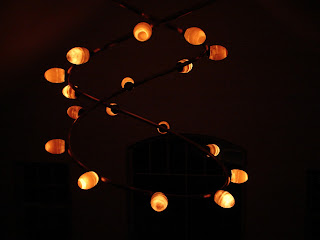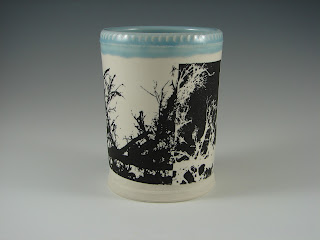 |
Cup, porcelain with "in-glaze" decal, H. 4.5'', 2011.
|
I have been using decals in some of my work ever
since the
Haystack class with Andy Brayman, in which I learned how to screen-print decals using ceramic ink. The decal used on the above cup is an "in glaze" decal, where, after the decal is applied, the cup is fired to cone 2 and the ink actually melts into the glaze, as opposed to over glaze or "on glaze" decal which is fired to cone 017 and sits on top of the glaze (permanently fused).
In thinking about what subject matter I might like to incorporate, I settled on a section of navigational charts from Penobscot Bay. These particular charts
are straight from familiar parts of the bay which I have had the privilege of
boating in since childhood. The imagery is nostalgic for me, and reminds me of
how awesome the summer time in Maine is, learning how to read charts with my
dad, and driving the launch at Wayfarer Marine as a summer job.
 |
4oz. Cups, porcelain and decals, H. 3.5'', 2012.
|
 |
10 oz cups, porcelain and decals, H. 4.5'', 2012.
|
 |
4oz. Cups, porcelain and decals, H. 3.5'', 2012.
|
I love how when
printed in one contrasting tone, the lines and text stand out visually against
the rich glaze. The idea for a decaled bottom surface comes from wanting to
integrate the bottom somehow into the user’s experience, and so it’s not just
plain raw porcelain. When you are sitting across from someone, you catch a
glimpse of the chart as they take a drink, and go from there. Out on your
yacht, before you pour your drink, or maybe after you’ve had one, you turn the
cup over and ponder which cove you might visit tomorrow morning, or
memorize where the rocks are around your favorite anchorage... Okay, that might
be a stretch for some, but it seems that people (locals and vacationers alike) recognize that the decals are there as more than just an interesting decoration - the charts become a connection between person, place, and piece.
Below is my current work that includes chart decals. These are decals that I ordered from a company that screen prints lead-free, monotone decals. They also digitally print full color decals, however most contain trace amounts of lead. I plan to someday set up my own printing area, as it is always better when you can make it yourself! One of the drawbacks to ordering from a company is that their standards of quality might not be as high as yours, and they probably use commercially available inks - which have generally been sitting on a shelf for years and years, and can tend to not print very well.
 |
4oz. Cups, porcelain and decals, H. 4.5'', 2013.
|
 |
5oz. Cups, porcelain and decals, H. 2.25'', 2013.
|
 |
10oz. Cups, porcelain and decals, H. 4.5'', 2013.
|
 |
Whiskey Cups, porcelain and decals, H. 2.5'', 2013.
|
 |
Pint Cups, porcelain and decals, H. 6.5'', 2013.
|
 |
| Salt Cellars with chart wrapped bottom, porcelain and decals, H. 1.5'', 2013. |





























